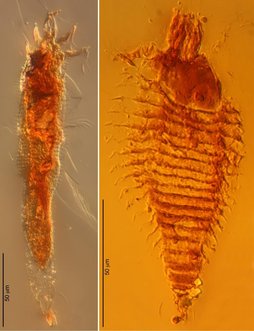Prehistoric Tiny Bugs Found Trapped In Amber

Scientists have found three well preserved ancient insects frozen in amber — and time — in what is Earth's oldest bug trap.
The discoveries of amber-encased insects in Italy may sound like something out of "Jurassic Park" but these bugs are even older than that. They are about 230 million years old, which puts them in the Triassic time period, and about 100 million years older than what had been the previously known oldest critters trapped in fossilized tree resin, or amber.
Gooey tree resin is like sap but without water and can't be diluted.
Researchers painstakingly examined 70,000 droplets of amber found in northeastern Italy. Stuck in them were two microscopic mites and much of one fly. The mites are too small to be seen with the naked eye and the fly is a tad tinier than a fruit fly, researchers say.
The discovery was reported Monday in the Proceedings of the National Academy of Sciences.
While older insects have been found in rock fossils, these are different because they are not compressed and better preserved, said study lead author David Grimaldi, curator of the American Museum of Natural History in New York. And you can see more detail, he said.
"''That's the great thing about amber. You can make this incredible detailed comparison with living species." Grimaldi said.
And when Grimaldi compared the ancient mites to their modern day descendants, he was surprised about how similar they are. Except for difference in the mouth and fewer legs, "they're dead ringers for (modern) gall mites," he said. The modern ones can be found in bubbles or galls on plant leaves.
And that's surprising because the world itself has changed a lot from when these bugs were alive. Back then, there was only one giant continent, some early primitive dinosaurs and no flower plants. Mites now live on flowering plants, but their ancient relatives must have stayed on trees, Grimaldi said.
Derek Briggs, director of the Yale Peabody Museum of Natural History and who wasn't part of the research, called the bugs' discovery tantalizing, adding that it could help researchers further understand how life evolved on land.
This discovery was made in the early 1980s by the late Professor Aftim Accra, Professor of Environmental Health, Faculty of Health Sciences, American University of Beirut. One could google Prof Acra or search the journal publications. Thank you
While late Dr. Accra also built his research on his professor's, which is how science evolves, did he analyze 230 million year old Amber or did he base his work on Lebanese insect bearing amber dating back to about 135 million years only? This article seems to basically say that insect bearing amber that is 100 million years older than previously found in Lebanon and Jordon was discovered in Northeastern Italy, which seems amazing regardless of authorship rights. Well done.



